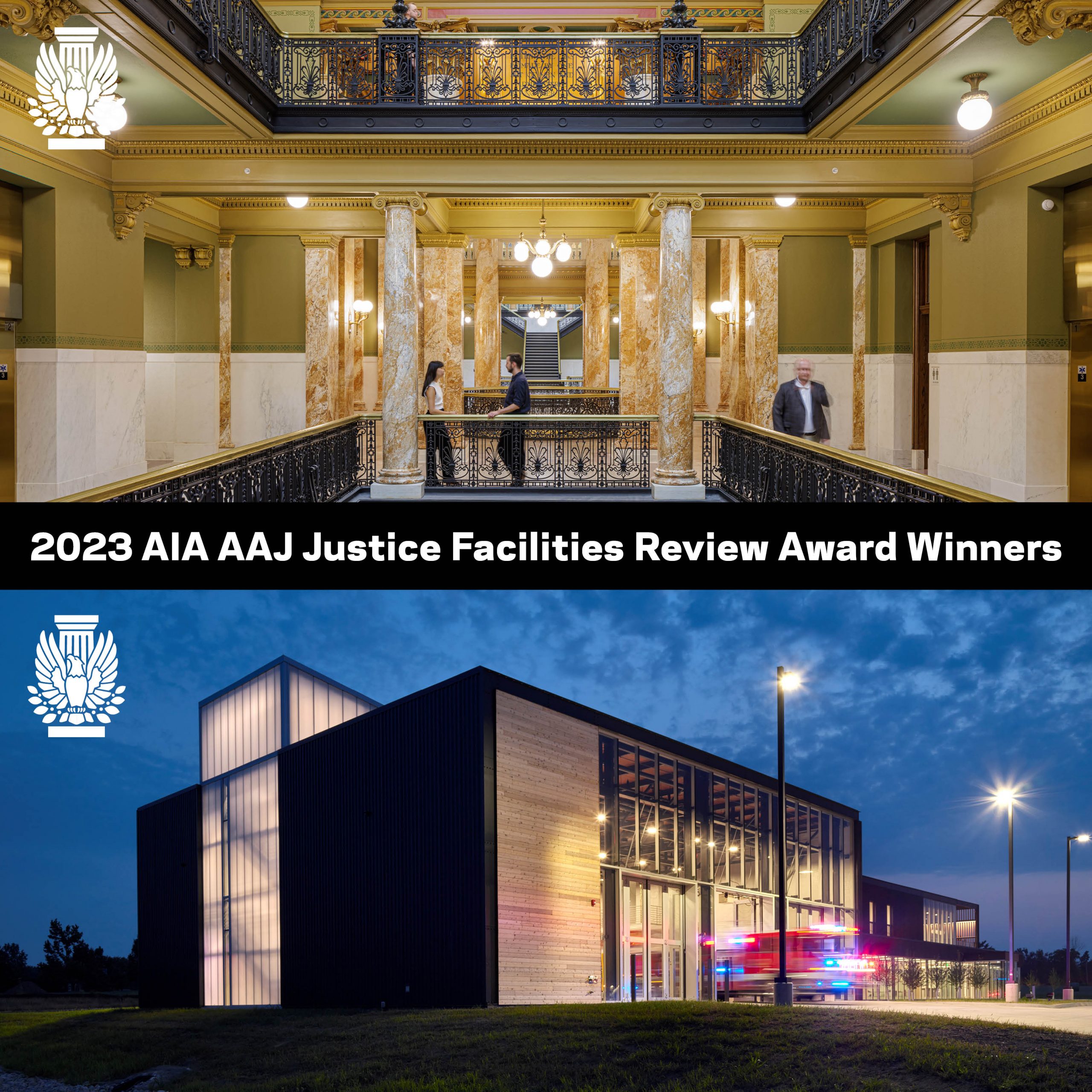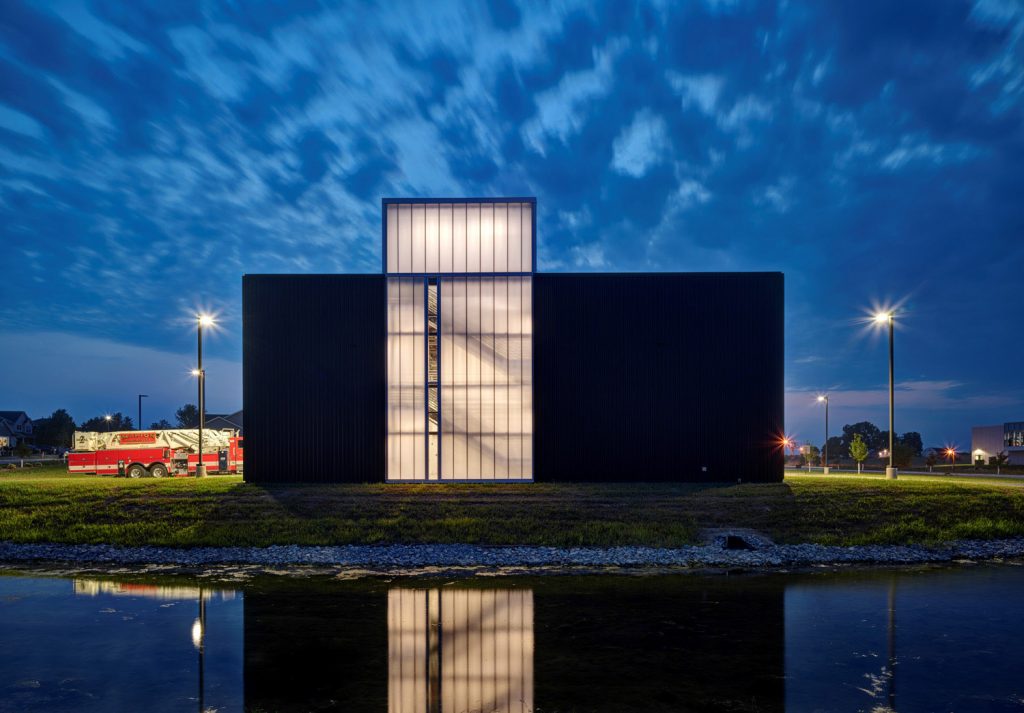Historic courthouse and fire station win Justice Facility Review awards

Polk County Historic Courthouse and Marion Fire Station 1 have been honored by the American Institute of Architects Academy of Architecture for Justice with a 2023 Justice Facilities Review Award.
The Justice Facilities Review documents best practices in planning and design for justice architecture. The winners demonstrate quality of form, functionality, and architectural response to six essential elements of justice facility design: functionality, security and safety, technology and accessibility, community impact, sustainability and economic feasibility (first cost and long-term cost of ownership), and aesthetic achievements.
This year four projects were honored by the AAJ. Awards were announced at the annual conference in Washington, D.C. in November.
Polk County Historic Courthouse
The restoration of the Polk County Historic Courthouse is the final phase of a multi-year reorganization of the Polk County Courts campus in downtown Des Moines. Facing
overcrowding and aging facilities, the county considered relocating its court functions to the suburbs. Instead of decommissioning the historic courthouse, the multi-phase
Fifth Judicial District Master Plan formed a new cohesive courts campus downtown by re-using two existing buildings to create a new Polk County Justice Center (2016) and
new Polk County Criminal Courts (2019) adjacent to the original 1906 historic courthouse. Use of Indiana limestone, glass curtainwalls, and zinc cladding at exteriors unify
the urban courts campus. All three buildings are now equitable, accessible, transparent in their function, navigable, and welcoming.
The restoration of the Historic Polk County Courthouse accommodates the functional needs of the Fifth Judicial District while also preserving the defining characteristics of the 1906-Beaux Arts Classical style structure. Over the years, historic elements including ornate plaster ceilings, lobbies, original doors, stairs, millwork and historic finishes and lighting had been replaced, hidden, or covered up in their entirety. The restoration and preservation of the historic courthouse brings the century old building back to life by uncovering and restoring much of its original details and architecture. Throughout the building, dropped ceilings were removed to reveal original ornate plaster moulding in disrepair. In each of the six original courtrooms a century’s worth of dirt, smoke, and grime were also removed from all the existing marble, terrazzo flooring, and woodwork. Once the patchwork of tile ceilings, carpet, and paint were removed, historically accurate plaster repairs and paint schemes were restored. Modern elements that were added are clearly distinguished in material and form in compliance with the Secretary of the Interior’s Standards for Rehabilitation.
The historic courthouse is the third and final project of the Polk County Courthouse Campus in downtown Des Moines, Iowa. Both the Justice Center and the Criminal Courts buildings were also recognized by the AAJ with a Justice Facilities Review Award.
“What stands out is the courthouse’s longevity, being on its second or third life. The approach to its restoration was very well done, and it has a presence that demands respect. It is also amazing that the team could maintain the court’s full operation during the span of the project.” – Jury comment
Marion Fire Station 1
 Challenged by the fire chief to design a station that would be a national benchmark for how biophilic design can reduce PTSD in fire fighters, the design of a the new two-level 21,000-square-foot Marion Fire Station 1 in a rapidly growing community achieved its three primary goals: reduce response times, use biophilic design principles to support fire fighters mental well-being, and establish a strong and transparent civic presence.
Challenged by the fire chief to design a station that would be a national benchmark for how biophilic design can reduce PTSD in fire fighters, the design of a the new two-level 21,000-square-foot Marion Fire Station 1 in a rapidly growing community achieved its three primary goals: reduce response times, use biophilic design principles to support fire fighters mental well-being, and establish a strong and transparent civic presence.
The new fire station is the third for the city of Marion, Iowa, population 41,535. The building, which also serves as the fire department’s headquarters, is the city’s first new station since 1991, when it was less than half the size it is today. Its location on the city’s northern edge was selected to ensure that the department continues to meet the national response time standards as the city grows over the next decade.
The focus on well-being pushed the building to be highly transparent in areas that have historically been designed with limited access to views and natural daylight in fire stations. Biophilic elements, including natural materials, daylight, views, access to the outdoors, and circadian rhythm-based lighting, are having a profound effect on
the firefighters’ wellbeing, including stress reduction and increased awareness and cognitive ability.
Shou sugi ban wood, charred using controlled fire, wraps the living and office spaces. Shou sugi ban is a technique that dates back to 18th-century Japan. The ancient process paradoxically makes the wood fire-resistant. Representing the mastery of fire, the material’s beauty suggests fire’s regenerative power and nature’s resilience.
“It is surprising to see wood used as a material in a fire station, but it provides the human touch that firefighters need for their workspace. The attention to the firefighters’ needs is so apparent in how the team shaped the station’s daylighting and congregate spaces. It serves as a very different example of what a fire station can be.” – Jury comment
Marion Fire Station 1 is only the second fire station to be honored by with a Justice Facilities Review Award. The first was another OPN-design project – Madison Fire 14.

